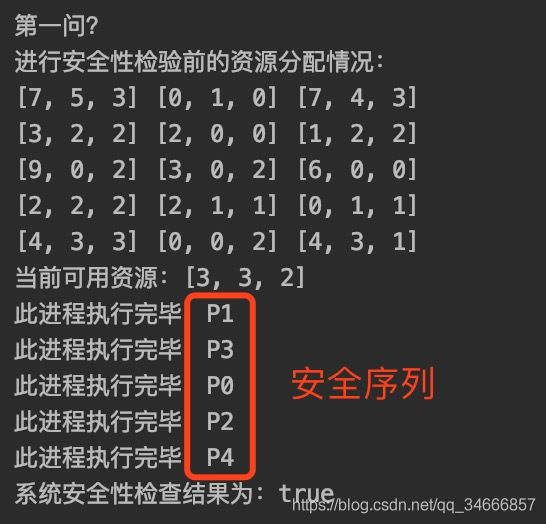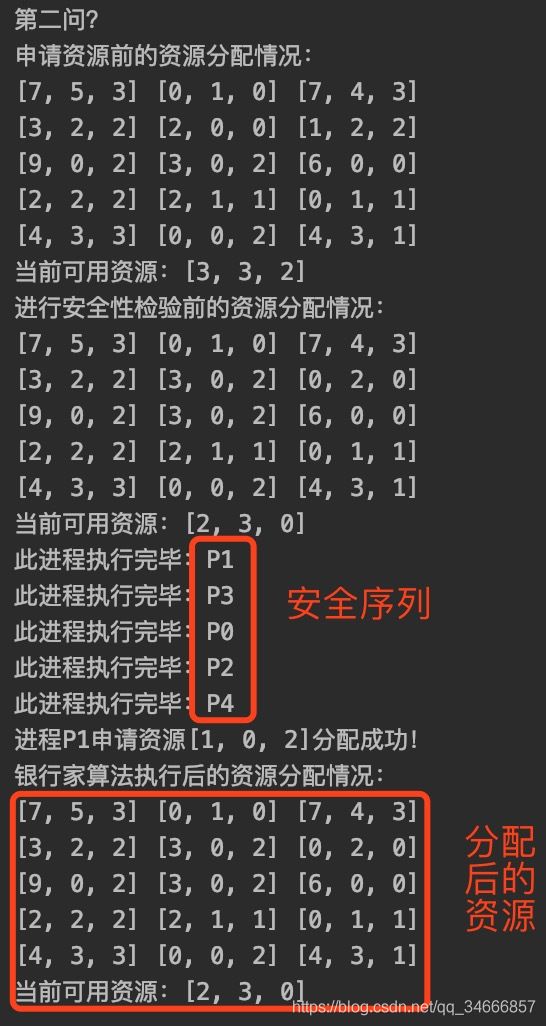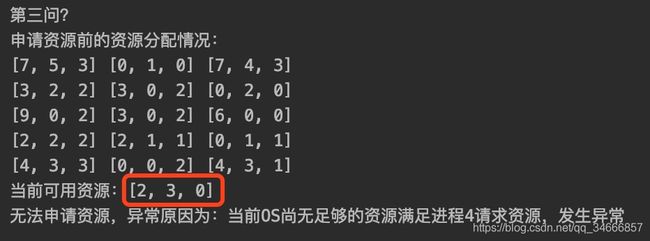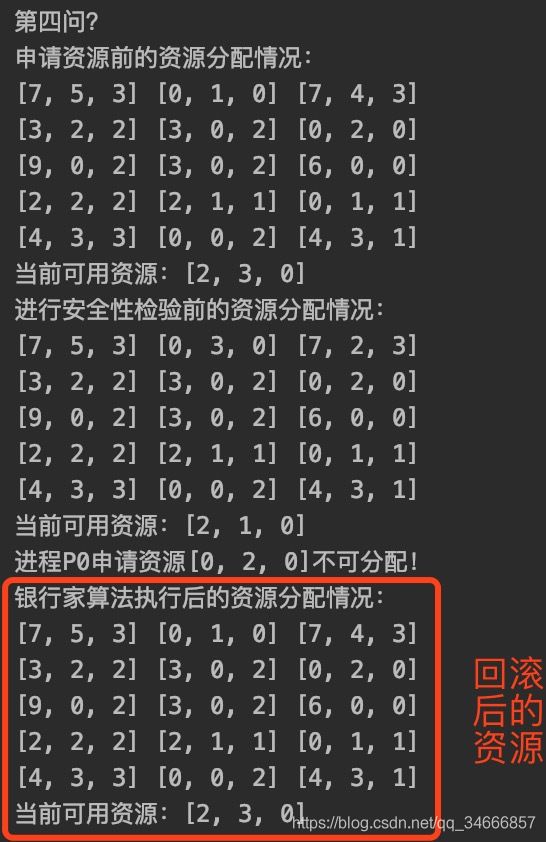Java模拟实现银行家算法
Java模拟实现银行家算法
在上一文中我们详细的讨论了银行家算法,包含其数据结构、算法步骤和安全性算法,在本文中,我们使用Java语言来实现银行家算法,并以上一文中的题目来进行验证。
关于银行家算法的具体细节,请参看上篇博文。
首先,我们给出银行家算法的执行流程图:

下面我们就步入正题,一起来看下银行家算法的实现吧:
首先就是数据结构的定义,分别为可利用的资源、所有进程对资源的最大需求、系统中的资源分配、以及所有进程仍需要的资源情况。
//可利用资源变量
private List<Integer> available = new ArrayList<>();
//最大资源需求矩阵
private List<List<Integer>> max = new ArrayList<>();
//资源分配矩阵
private List<List<Integer>> allocation = new ArrayList<>();
//仍需资源需求矩阵
private List<List<Integer>> need = new ArrayList<>();
对于Requesti,我们使用如下结构来定义:
@Data
public class RequestSource {
//请求资源的进程编号
private int id;
//请求的资源列表
private List<Integer> source;
}
然后我们来看下银行家算法的主体代码:
//银行家算法
public void bankerAlgorithm(RequestSource request) throws Exception {
//请求资源进程的编号
int id = request.getId();
//判断请求资源是否超过进程所声明的最大需求数
for (int i = 0; i < available.size(); i++) {
if (request.getSource().get(i) > need.get(id).get(i)) {
throw new Exception("进程P" + id + "请求资源超过其申明的最大值,发生异常");
}
}
//判断OS当前是否可以满足进程此次的资源请求
for (int i = 0; i < available.size(); i++) {
if (request.getSource().get(i) > available.get(i)) {
throw new Exception("当前OS尚无足够的资源满足进程P" + id + "请求资源,发生异常");
}
}
//进行资源的试探分配
resourceAllocation(request);
//进行安全性检查
if (!securityCheck()) {
rollbackAllocation(request);
System.out.println("进程P" + id + "申请资源" + request.getSource() + "不可分配!");
} else {
System.out.println("进程P" + id + "申请资源" + request.getSource() + "分配成功!");
}
}
//资源分配,直接分配,如果安全性检查不通过,进行资源回滚释放
private void resourceAllocation(RequestSource request) {
//请求资源进程的编号
int id = request.getId();
List<Integer> requestSource = request.getSource();
//当前进程已经分配的资源
List<Integer> currentAllocation = allocation.get(id);
//当前进程仍需的资源
List<Integer> currentNeed = need.get(id);
//修改可利用资源数量、已分配资源、仍需求资源
//注:因为在前面已经判断过request<=need和available,所以资源不会变成负,不需要处理异常
for (int i = 0; i < available.size(); i++) {
available.set(i, available.get(i) - requestSource.get(i));
currentAllocation.set(i, currentAllocation.get(i) + requestSource.get(i));
currentNeed.set(i, currentNeed.get(i) - requestSource.get(i));
}
//更新总的分配矩阵
allocation.set(id, currentAllocation);
//更新总的需求矩阵
need.set(id, currentNeed);
}
//安全性检查算法
private boolean securityCheck() {
//步骤1:初始化临时变量work和
List<Integer> work = new ArrayList<>();
work.addAll(available);
int processCount = max.size();
List<Boolean> finish = new ArrayList<>();
for (int i = 0; i < processCount; i++) {
finish.add(false);
}
//i表示已执行多少个进程,id表示可执行的进程号,j表示资源的类型
int i, j, id;
//在步骤1中是否找到一个能满足条件的进程,即是否有进程可以执行完毕,释放资源
boolean flag;
//步骤1:从进程集合中找到满足条件的进程
for (i = 0; i < processCount; i++) {
flag = false;
for (id = 0; id < processCount; id++) {
//finish为true表示可以获得所需资源,顺利执行完毕
if (finish.get(id)) {
continue;
}
List<Integer> currentNeed = need.get(id);
//j表示资源的类型
for (j = 0; j < work.size(); j++) {
if (currentNeed.get(j) > work.get(j)) {
break;
}
}
//当前进程id所需的资源可以得到满足,转而执行步骤2
if (j == work.size()) {
//步骤2
List<Integer> currentAllocation = allocation.get(id);
for (j = 0; j < work.size(); j++) {
//进程可以顺利完成,释放资源
work.set(j, work.get(j) + currentAllocation.get(j));
}
//更改标志位
finish.set(id, true);
flag = true;
//跳出循环,执行步骤1
System.out.println("此进程执行完毕:P" + id);
break;
}
}
//上接break
//判断是否进程分配资源,扫描进程集合一遍,如未分配资源,则表示没有进程可以继续执行,
//立刻跳出循环,转而执行步骤3
if (!flag) {
break;
}
}
//步骤3:判断是否所有进程的finish标志位是否全为true
for (id = 0; id < processCount; id++) {
//如果有一个为false,则处于不安全状态
if (!finish.get(id)) {
return false;
}
}
return true;
}
//安全性检查不通过,回滚刚才分配的资源
private void rollbackAllocation(RequestSource request) {
//请求资源进程的编号
int id = request.getId();
List<Integer> requestSource = request.getSource();
//当前进程已经分配的资源
List<Integer> currentAllocation = allocation.get(id);
//当前进程仍需的资源
List<Integer> currentNeed = need.get(id);
//修改可利用资源数量、已分配资源、仍需求资源
//注:因为在前面已经判断过request<=need和available,所以资源不会变成负,不需要处理异常
for (int i = 0; i < available.size(); i++) {
available.set(i, available.get(i) + requestSource.get(i));
currentAllocation.set(i, currentAllocation.get(i) - requestSource.get(i));
currentNeed.set(i, currentNeed.get(i) + requestSource.get(i));
}
//更新总的分配矩阵
allocation.set(id, currentAllocation);
//更新总的需求矩阵
need.set(id, currentNeed);
}
为了方便的展示系统的资源分配情况,需要写一个print函数:
private void printResourceAllocationPic() {
for (int i = 0; i < max.size(); i++) {
System.out.println(max.get(i) + " " + allocation.get(i) + " " + need.get(i));
}
System.out.println("当前可用资源:" + available);
}
最后我们使用上一篇中的例子来进行验证,题目修改后如下:
例题:假定系统中有五个进程{P0, P1, P2, P3, P4}和三类资源{A, B, C},各种资源的对应数量为10、5、7,在T0时刻的资源分配图如下图所示。
(1)请检查T0时刻的安全性。
(2)进程P1发出请求向量Request1(1, 0, 2),为保证系统安全,系统能否将资源分配给它?
(3)进程P4发出请求向量Request4(3, 3, 0),为保证系统安全,系统能否将资源分配给它?
(4)进程P0发出请求向量Request0(0, 2, 0),为保证系统安全,系统能否将资源分配给它?
测试代码如下:
@Test
public void bankTest() throws Exception {
Integer[][] maxArray = {
{
7, 5, 3}, {
3, 2, 2}, {
9, 0, 2}, {
2, 2, 2}, {
4, 3, 3}};
for (Integer[] tmpArray : maxArray) {
max.add(Arrays.asList(tmpArray));
}
Integer[][] allocationArray = {
{
0, 1, 0}, {
2, 0, 0}, {
3, 0, 2}, {
2, 1, 1}, {
0, 0, 2}};
for (Integer[] tmpArray : allocationArray) {
allocation.add(Arrays.asList(tmpArray));
}
Integer[][] needArray = {
{
7, 4, 3}, {
1, 2, 2}, {
6, 0, 0}, {
0, 1, 1}, {
4, 3, 1}};
for (Integer[] tmpArray : needArray) {
need.add(Arrays.asList(tmpArray));
}
Integer[] availableArray = {
3, 3, 2};
available = Arrays.asList(availableArray);
//第一问
System.out.println("第一问?");
//printResourceAllocationPic();
System.out.println("系统安全性检查结果为:" + securityCheck());
// printResourceAllocationPic();
System.out.println();
System.out.println("第二问?");
//第二问
//构建进程request对象
RequestSource request = new RequestSource();
request.setId(1);
List<Integer> requestSource = new ArrayList<Integer>() {
{
add(1);
add(0);
add(2);
}};
request.setSource(requestSource);
System.out.println("申请资源前的资源分配情况:");
printResourceAllocationPic();
bankerAlgorithm(request);
System.out.println("银行家算法执行后的资源分配情况:");
printResourceAllocationPic();
//第三问
System.out.println();
System.out.println("第三问?");
try {
request.setId(4);
Integer[] requestArray = {
3, 3, 0};
requestSource = Arrays.asList(requestArray);
request.setSource(requestSource);
System.out.println("申请资源前的资源分配情况:");
printResourceAllocationPic();
bankerAlgorithm(request);
printResourceAllocationPic();
} catch (Exception e) {
System.out.println("无法申请资源,异常原因为:" + e.getMessage());
}
//第四问
System.out.println();
System.out.println("第四问?");
request.setId(0);
Integer[] requestArray = {
0, 2, 0};
requestSource = Arrays.asList(requestArray);
request.setSource(requestSource);
System.out.println("申请资源前的资源分配情况:");
printResourceAllocationPic();
bankerAlgorithm(request);
System.out.println("银行家算法执行后的资源分配情况:");
printResourceAllocationPic();
}
执行结果如下图所示:

从图中可以看到,安全序列为{P1,P3,P0,P2,P4},因此T0时刻OS处于安全状态。

从图中可以看到,资源分配后,OS中还存在安全序列为{P1,P3,P0,P2,P4},因此通过了安全性检查,因此可以进行资源分配,分配后的资源如图中下方红框所示。

因为此时系统中的Available=(2, 3, 0),因此无法满足Request4(3, 3, 0)。

由上图可知,资源试探分配给进程P0后,无法满足任何进程,因此不存在安全序列,故回滚资源。
总结
本文中使用Java语言模拟实现银行家算法,上面所有所有代码放到一个类中即可实现(不包含RequestSource,需单独一个文件)。算法有较强的扩展性,资源种类可变,进程数可变,有想法的同学可考虑使用Java多线程来模拟死锁问题,并使用银行家算法来避免死锁。这一定会非常有趣。
又到了分隔线以下,本文到此就结束了,本文内容全部都是由博主自己进行整理并结合自身的理解进行总结,如果有什么错误,还请批评指正。
如有兴趣,还可以查看我的其他几篇博客,都是OS的干货,原创不易,喜欢的话还请点赞、评论加关注_。
操作系统武功修炼心法